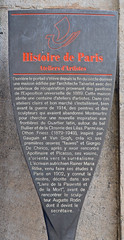.jpg?width=250)
.jpg?width=250)
Giorgio De Chirico
(1888-1978)
man
Died aged 90
Wikidata WikipediaGiuseppe Maria Alberto Giorgio de Chirico (/ˈkɪrɪkoʊ/ KIRR-ik-oh, Italian: [ˈdʒordʒo deˈkiːriko]; 10 July 1888 – 20 November 1978) was an Italian artist and writer born in Greece. In the years before World War I, he founded the scuola metafisica art movement, which profoundly influenced the surrealists. His most well-known works often feature Roman arcades, long shadows, mannequins, trains, and illogical perspective. His imagery reflects his affinity for the philosophy of Arthur Schopenhauer and of Friedrich Nietzsche, and for the mythology of his birthplace. After 1919, he became a critic of modern art, studied traditional painting techniques, and worked in a neoclassical or neo-Baroque style, while frequently revisiting the metaphysical themes of his earlier work.
DbPedia
Commemorated on 1 plaque
Ateliers d'Artistes Derrière le portail s'élève depuis la fin du siècle dernier une maison édifiée par l'architecte Taberlet avec des matériaux de récupération provenant des pavillons de l'Exposition universelle de 1889. Cette maison abrite une centaine d'ateliers d'artistes. Dans ces ateliers clairs et bon marché s'installèrent, bien avant la guerre de 1914, des peintres et des sculpteurs qui avait abandonné Montmartre pour chercher une nouvelle inspiration aux frontières du Quartier latin, autour du bal Bullier et de la Closerie des Lilas. Parmi eux, Othon Friesz (1879-1949), inspiré par Gauguin et Van Gogh, créa ici ses premières oeuvres "fauves" et Giorgio De Chirico, après y avoir rencontré Apollinaire et Picasso, ses voisins, s'orienta vers le surréalisme. L'écrivain autrichien Rainer Maria Rilke, venu faire ses études à Paris en 1902, y connut la misère, décrite dans son "Livre de Pauvreté et de la Mort", avant de rencontrer le sculpteur Auguste Rodin dont il devint le secrétaire.
English translation: Artists' Workshops Behind the portal has since the end of the last century been a house built by the architect Taberlet with recovery materials from the pavilions of the Universal Exhibition of 1889. This house houses about 100 artists' workshops. In these clear and inexpensive workshops, long before the War of 1914, painters and sculptors who had abandoned Montmartre to seek new inspiration at the borders of the Latin Quarter, around the Bullier Ball and the Closerie des Lilas. Among them, Othon Friesz (1879-1949), inspired by Gauguin and Van Gogh, created his first “fake” works here and Giorgio De Chirico, after meeting Apollinaire and Picasso, his neighbours, moved towards surrealism. Austrian writer Rainer Maria Rilke, who came to Paris in 1902, experienced poverty, described in his “Book of Poverty and Death”, before meeting the sculptor Auguste Rodin, of whom he became secretary. [AWS Translate]
9 rue Campagne-Première, Paris, France where they worked
